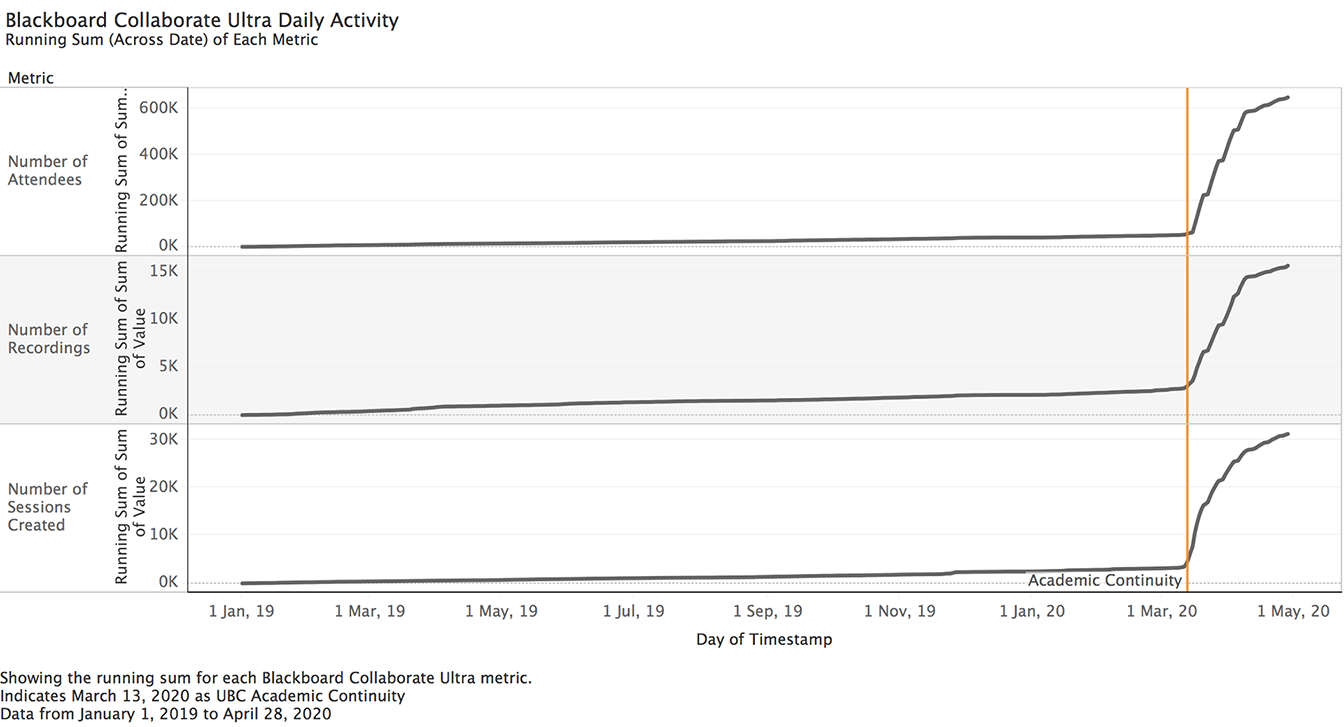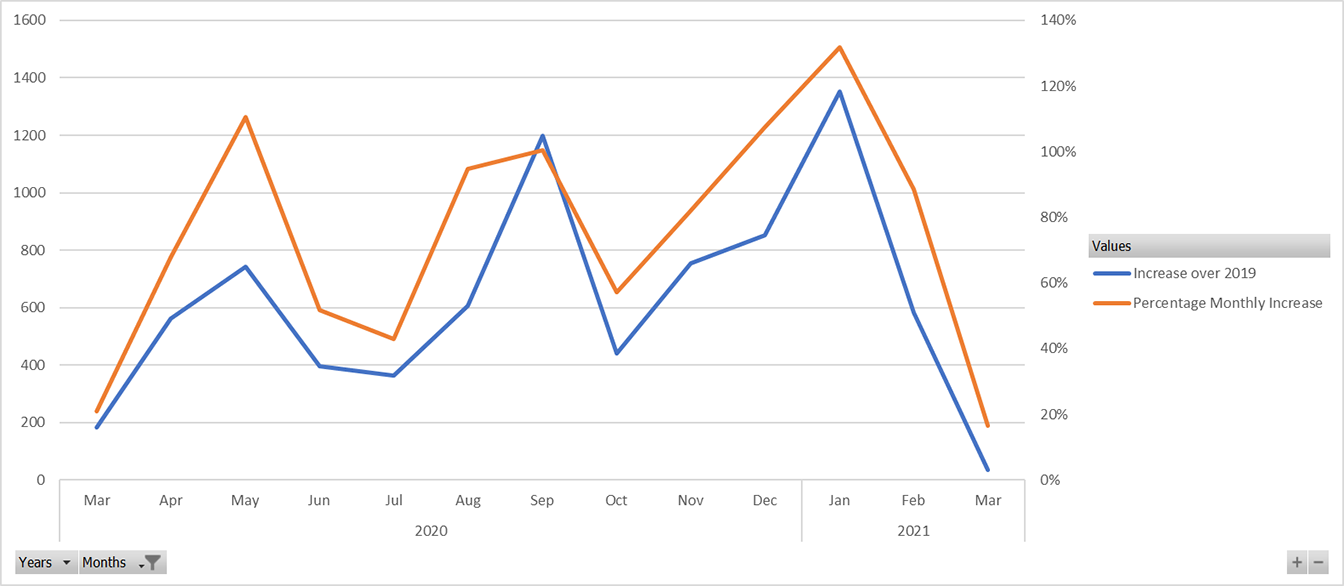In our April edition of Edubytes, we follow on from our March editorial on the year of teaching and learning at UBC, by reflecting on the changes to the learning technology environment following that emergency transition.
Stephen Michaud, senior manager, learning applications integrations and analytics at the UBC Centre for Teaching, Learning and Technology and co-lead of the Learning Technology Hub (LT Hub), shares how UBC’s use of learning technologies has altered.
A quick transition to online
On March 13, 2020, UBC announced the transition of all teaching and learning online, and for all staff that could to start working from home. For about a week leading up to this decision, the LT Hub, a collaborative unit consisting of staff from UBC IT and the Centre for Teaching, Learning and Technology (CTLT), had been preparing for just such an event. The Keep Teaching and Keep Learning websites were quickly stood up, with easy to read and follow instructions and advice for moving teaching and learning online.

Figure 1: Blackboard Collaborate Ultra usage at UBC, showing the dramatic increase in attendees, recording and sessions starting from the day classes and lectures were moved online.
During the days, weeks, and months that followed, the patterns of learning technology usage at UBC changed dramatically. Virtual meeting tools like Blackboard Collaborate Ultra and Zoom saw enormous leaps in usage, as did tools aimed at assessment and engagement.
New year, exploring new tools
As the situation extended through summer and into the 2020/21 academic year, we saw a shift from high usage of those initial tools as instructors explored a more diverse range. Figure 2 shows the increase in tool usage in courses, as a percentage of the courses using those tools, at the start of the month (the use of the start of the month as a baseline corrects for spikes that are seen at the start of terms as courses are created). As noted in Figure 1, Blackboard Collaborate Ultra usage increased in May, but another major change came in September, as Zoom was also made available and was adopted broadly.
The rise of assessment tools like Proctorio, Quizzes 2, WebWork, Gradescope, and Lockdown Browser, and engagement tools such as ComPAIR, iClicker Sync, peerScholar, and Piazza, at the start of the fall term, are a clear result of instructors further adapting to the new online reality.
- In a May 2020 interview with the Georgia Straight, Associate Provost, Teaching and Learning Dr. Simon Bates described UBC’s response to the initial move online. He also talks about the plans for the first fully online terms and speculation to what changes might continue post pandemic.

Figure 2: Increased addition of learning tools in courses (shown as a percentage difference from the start of the month).
Expanding technology supports
As demand for learning tools increased, the demand for assistance and aid grew just as dramatically. The LT Hub saw hundreds more requests, double the previous year in many months, as shown in figure 3.
In the past, the LT Hub had provided help for students through their instructors and TAs, but of the increase in help requests, approximately a quarter was supporting students directly. In time-constrained situations such as midterms and exams, time is precious for students, especially in this anxiety loaded situations, so the LT Hub moved to directly support students.
The efforts made have not gone unnoticed, with the LT Hub, faculty-based instructional support staff, and the UBC Okanagan’s Centre for Teaching and Learning receiving praise in feedback from many instructors and students, and most recently from the Vancouver Senate during their most recent session.

Figure 3: Increase in help requests to the LT Hub
What’s next for ed tech
Institutions in North America, and across the world, have been facing similar challenges and changes, so there is a wealth of articles, resources, and emerging research on the changes in educational technology (or ‘ed tech’) through this period. The following articles come from three of the (arguably) most respected voices in ed tech today.
- Research reports on COVID-19 and emergency remote learning/online learning: One of the best resources for research on the topic of the impact the COVID-19 situation has had on higher education. Dr. Tony Bates has curated a great list of resources and provides his own summary and commentary on the papers.
- Re-integration: The new phase in COVID response by education: The latest article in a series from Phil Hill. He outlines, with the help of a webinar by D2L’s Ken Chapman and NYU’s Clay Shirky, a missing phase in pandemic education: the transition back to the new normal.
- Some changes will be permanent: Lastly, Michael Feldstein brings his unique perspective to what might shape the new normal to come. The steps that have been taken to support learning during the pandemic, and the changes people made in their lives, will forever change expectations on how online education can and should be delivered in the years to come.
UBC is preparing to resume primarily in-person instruction for the fall term 2021, while acknowledging the possibility of changes in direction from the BC Provincial Government. Students, instructors, and staff have worked through many of the hurdles to online learning over the fifteen months leading up to fall 2021, and there are aspects of that rich online experience that many will want to retain going forward. What that ‘new normal’ looks like as we transition back to the physical campuses is unknown, but exciting.
Enjoyed reading about changes in the learning technology landscape? Learn about other topics we covered in the April 2021 edition by reading the complete Edubytes newsletter. To view past issues, visit the Edubytes archive.
Are you interested in staying up to date on the latest trends in teaching and learning in higher education? Sign up for our newsletter and get this content delivered to your inbox once a month.

